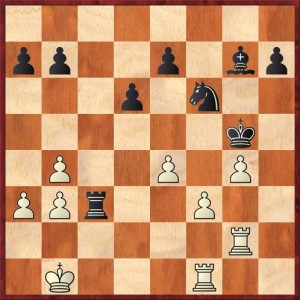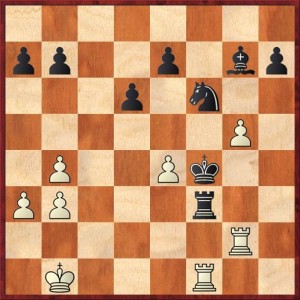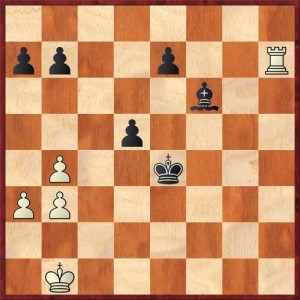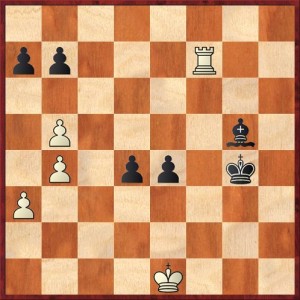I’d like to talk today about a complex position from one of Linnea’s games last week in the U.S. Game/60 Championship.
As Linnea was showing me the game, she played 27. … Rxb3+ almost instantaneously, as if there was no question about it. I got the feeling she had played equally automatically in the game, too. The pawn is hanging with check, so obviously you take it, right?
I asked her, “Wait, don’t you want to stop and think before you take? Maybe there is a better move. Why not play 27. … Kf4 here?” My thinking was this: instead of reflexively grabbing a rather lame pawn on b3, I’d rather use the move to improve my position and increase the pressure on White. If I can win the f3 pawn, it’s a much more important accomplishment because White’s center will collapse. And if White is forced to defend with 28. R2f2, then I can continue with 28. … Nd7 and … Ne5 and win at my leisure.
Well, there is one problem with this scenario, which I’m sure you have noticed. After 27. … Kf4 White counterattacks with 28. g5! Now my idea was to leave the knight en prise with 28. … Rxf3!?
This was again not a move that Linnea had considered, and I talked to her a little bit about “thinking outside the box” and not automatically moving the knight from f6 just because it’s attacked. In fact, we see that in this position White cannot take the knight right away because of 29. gf? Rxf1+. (Aren’t you glad that we left the White king on b1 instead of checking it to a2?)
However, of course, White can trade rooks first and then take on f6: 29. Rxf3+ Kxf3 30. gf. Unfortunately Black does not have time to grab White’s rook with 30. … Kxg2?? because of 31. fg and the pawn queens. So Black has to play 30. … Bxf6. It then looks as if White’s best is 31. Rh2 (he doesn’t want the h-pawn to live) 31. … Kxe4 32. Rxh7 d5 and we reach the following position.
I thought this position looked pretty good for Black. White’s pawn majority on the queenside does not really matter, and Black’s connected passers in the center look strong. But to my surprise, Rybka 3 did not agree with my evaluation and gave White a slight plus.
I’m still not quite sure if I believe this. After we played on a few more moves: 33. Kc2 d4 34. Rh3 Bg5 35. b5 e5 36. b4 Kf4 37. Kd3 Bf6 38. Rh7 e4+ 39. Kd2 Bg5 40. Rf7+ Kg4+ 41. Ke1 (all moves that can be debated, but they are at or near the top of Rybka’s candidate moves list in each case), all of a sudden Rybka’s evaluation shifted from about even to 1.8 pawns in Black’s favor (i.e., Black is winning).
Of course these are the types of shenanigans that make computers frustrating to use. When they change their minds 10 moves into a variation, does that mean that their evaluation was wrong all along, or was there a mistake made somewhere in the middle?
My take on it is that Rybka mis-evaluated the position in diagram 3 and it is in fact very good for Black, not equal. Perhaps there was a horizon effect that kept the computer from seeing how dangerous Black’s passed pawns are. I’m surprised, though, because I thought Rybka had outgrown such things.
But let’s go back to the initial position and ask which was better: Linnea’s automatic move 27. … Rxb3+ or my more complicated suggestion, 27. … Kf4. What does the computer say here? It says emphatically that Linnea was right. After 27. … Rxb3+ it gives an evaluation of +1.8 pawns for Black, but after 27. … Kf4 the evaluation drops to something like +0.5 pawns.
And here, upon further consideration, I think that the computer is completely right. It’s an old issue that Mike Splane and I have talked about many times, an issue of patience versus haste. By playing 27. … Rxb3+, Black is saying that she is ahead in material (two pieces versus a rook) and she doesn’t have to do anything special to win. All she has to do is keep White’s rooks from getting to the seventh rank, where they would be dangerous. Thus, after 27. … Rxb3+ 28. Ka2, Rybka recommends 28. …Rc3, keeping control over the c-file. This of course allows a pawn advance with 29. f4+ Kg6 30. Re1, but Black doesn’t care. Black knows that it’s okay to retreat in the short term because the long-term factors in the position are completely in her favor. She just needs to keep the rooks under control and keeps her own pieces active. Patience is the key.
My move, 27. … Kf4, represents a completely different interpretation of the position. Black plays impatiently, forcing the action into a tactical variation where every tempo is critical. The evaluation of the whole line depends on your evaluation of the endgame in diagram three, which I believe is favorable for Black but is nevertheless razor-sharp and where Black could just as easily lose as win. From a practical point of view, there is no reason for Black to go into a line with a significant chance of losing, when she could play a solid line with little chance of losing.
So Linnea and I both learned a lesson from this position. For her the lesson was to think outside of the box. For me the lesson is not to fall in love with your own ideas. Yes, the move 27. … Kf4 should be considered, but it puts at risk what should be a safe advantage. 27. … Rxb3+ is correct.
By the way, the reason Linnea lost the game was that she played in a manner that in some ways combined the worst features of Rybka’s line and my line. She played 27. … Rxb3+ but then played … Kf4 later after she had already lost a couple of tempi. She was not able to keep White’s rooks from invading the seventh rank, her pieces became too passive and her king was too far away to help in the defense.







{ 4 comments… read them below or add one }
Since you mentioned my name …
I thnk Black is clearly winning in the initial position. My first rule when you are ahead is to restrict counterplay, so I would be avoiding tactics.
When I am about to spend a tempo capturing a pawn, I have learned to ask myself if the capture mades a big change to the evaluation of the position. If not I look for alternative. I agree with you that winning the b3 pawn generally is not a big gamechanger.
I would have played 1 … Kf4 but after 2. g5 instead of 2 … Rf3 I would have looked at … Nd7 3. Rh2 Nf8 when all of White’s counterplay is contained and at least one of the pawns on the 3rd rank falls.
I think your active approach might be improved by interpolating 2 … Rb3+ first and only then playing 3. Rf3.
Mike
If anything, I think the newest, strongest chess programs suffer more from the horizon effect than older ones. Remember that when an engine like Rybka or Houdini says it is searching, say, 20 plies, only about the first 6 or so plies in the move tree are actually full-width (considering all possible moves). Deeper into the tree, the move lists become aggressively pruned, increasing the likelihood of tactical lines being missed entirely. Much of the recent increase in engine strength has been due to tweaking of the algorithms that prune the tree, trying to trade off the number of moves examined at each ply for a deeper search. This helps engines beat other engines, but I think it ultimately hurts their value in game evaluation.
I agree with Mike and Dana in their interpretations. But just based on some 2 ply tactics – Rxb3+ leads to a king move attacking the rook, which will then have to move, followed by a check (f4+), making the king look a little silly, we should reject Rb3+.
Furthermore, as we can see, Kf4 is a blockading move, and the king is the best blockader in the game. Not only that, black isn’t obliged to ‘act’. As was remarked, she can just sit there doing nothing – Kf4, Nd7-e5, shuttle rook along rank (or if kicked, along the file). Pretty soon, white will have to take some stance and that can only be beneficial for black. The only thing for black to worry about is a rook infiltration on c7, so maybe the rook shouldn’t be traded.
Sometimes, it’s just better to play the waiting game. I often make the mistake of treating middlegame positions (dynamics, cheap shots, aggression) like static endgame formations, weak pawns, blockade, etc. But here, it’s just that kind of posiiton!
Linnea should probably read Chess Praxis for a bit of Nimzo dogma.
Yeah i agree with you,every known grandmasters read and know about chess praxis by nimzo.its a great book.and im happy i got a copy.most players choose tactical solutions and its very common.they forgot to defend..i think he must study the game of kramnik versus kasparov on their world championship duel.kasparov did not win a single game!.prophylaxis is a dangerous weapon